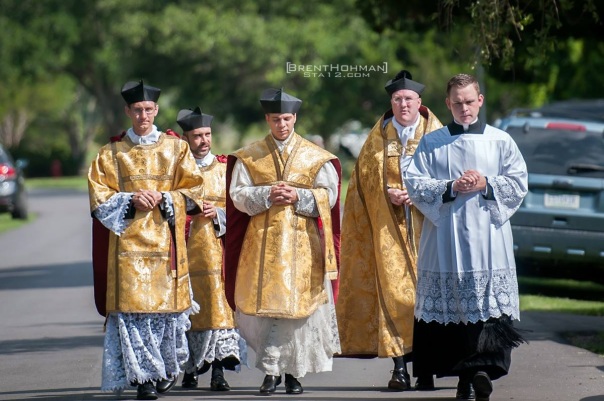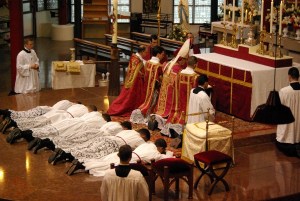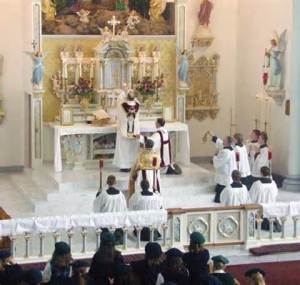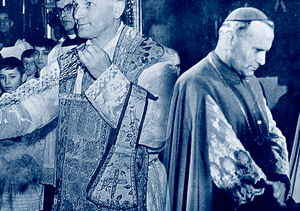November 8, 2013
For the past two years, Father Philip Clement has been one of the parochial vicars of Incarnation parish, near St. Petersburg, Florida. Father Clements studied philosophy at Christendom College and then attended St. Vincent de Paul Regional Seminary in Boynton Beach, Florida. He was ordained in 2008 and said his first Traditional Latin Mass on the First Sunday of Advent, November 27, 2011.

In this exclusive Regina Magazine interview, Father Clement recounts the story of how Incarnation Parish has become a beloved locale for the Latin Mass. The story of this parish shows us yet again how a thriving parish community with a strong future can grow, even against all expectations in a modern church, with an aging population.
Q. Tell us about Incarnation Parish.
Incarnation parish is located in the Town N Country area of Tampa, Florida, which is centrally located in the Diocese of St. Petersburg. It was created in 1962 and has roughly 3,200 families. The pastor is the Very Rev. Michael Suszynski, and he has been pastor of Incarnation parish for four years.
Q. How did you become involved with the TLM?

Early in 2011 I was asked by one of the three priests in our diocese who said the Latin Mass at that time if I could fill in for him while he was away on vacation. I did not know how to say the Latin Mass but had a deep interest in learning. This priest friend of mine instructed me on how to say the Mass, and with lots of study and practice, I was able to cover his parish’s Latin Mass while he was out of town.
Thereafter, I made opportunities in my schedule to make the 35 minute drive to his parish to continue helping him with his Latin Masses. Since my first Mass on November 27th, I’ve been hooked.
Q. When did you introduce the TLM?
Prior to 2012, Incarnation Parish did not have a Traditional Latin Mass. We also had a very unique situation, as our parish did not have a Sunday evening Mass on the schedule.

On February 20, 2012, I had dinner with the pastor, and at some point in the course of the conversation the fact that I had been saying the Traditional Latin Mass since the previous November came up, and he offered me the Sunday afternoon timeslot in which to offer the Latin Mass in our parish. Needless to say I was stunned, as that was not the purpose of our conversation, but he offered it anyway. I took it to prayer, and two days later I informed him that I would love the opportunity.
By that point I was proficient in saying the Low Mass and had learned much about the history of the Mass in general. Since the Traditional Latin Mass was relatively new to me, I assumed it would be for our parishioners as well, except for the few who might have remembered it from their childhood.

Since my first Mass on November 27th, I’ve been hooked.
Q. How did you get parishioners interested?
I decided to offer the parishioners a three-part seminar on the Traditional Latin Mass, which covered preparation for Mass, the Mass of the Catechumens and the Mass of the Faithful. It was a great success and was attended by over 200 people.
Each part of the seminar was given in successive weeks and ended on the fourth week with our inaugural Mass, the very first Traditional Latin Mass offered in our fifty year old parish on May 6, 2012.

Our three- part parish seminar on the Latin Mass was a great success and was attended by over 200 people.
Q. So, the Mass just took from there?
Not really. Immediately after May 6th, administrative problems prevented us from continuing with the Latin Mass for a period of six months. By November 4, 2012, we were able to add the Traditional Latin Mass to the regular Mass schedule. At that time it was only me saying the Latin Mass in our parish, and my schedule would only allow me to offer the Mass twice per month, and I was content in moving forward as such.

However, the following month I met a Jesuit priest at the local Jesuit High School in Tampa who knew how to say not only the Low Mass but the High Mass and the Solemn High Mass, and this offered our Traditional Latin Mass community a huge opportunity. Fr. Patrick Hough, S.J. came aboard January 20, 2013 and said his first Latin Mass at Incarnation. Now that Fr. Hough was available to assist with the Latin Mass, we were able to start offering the Traditional Latin Mass every Sunday, and we have been doing so since January of this year.
In addition to being able to offer the Latin Mass every Sunday, we were now able to start offering the High Mass and the Solemn High Mass as well. Incarnation had its first High Mass on February 24th of this year and our first Solemn High Mass on Pentecost Sunday, May 19th.

Q. That is a lot of work! What is the current situation?
Since that time I have been able to learn the High Mass and the priest and sub-deacon’s parts for the Solemn High Mass, which allows us to have a very full Sunday schedule each month. Currently, the first Sunday of the month is a Low Mass, followed by two High Masses on the second and third Sundays, and a Solemn High Mass on the fourth Sunday.
All in all, I believe we have come a long way in just one year. This should encourage any parish considering starting the Traditional Latin Mass to follow the Spirit’s lead, bring it to the people, and have confidence that there is much support for the Ancient Mass of the Saints.

We have come a long way in just one year. This should encourage any parish considering starting the Traditional Latin Mass to follow the Spirit’s lead, bring it to the people, and have confidence that there is much support for the Ancient Mass of the Saints.
Q. How has sacred music played a part in the transformation of your parish?
Yes. Before we could offer the High Mass or Solemn High Mass in our parish, we first needed to explore the opportunity of starting a sacred music program. In the beginning, we invited a chant schola from a neighboring parish to come to sing the Mass parts for our first High Mass. We also invited them to continue singing motets and hymns at our Low Masses, and interest continued to develop.
Soon thereafter we were able to start our sacred music program, as we had just hired a new Director of Music in the parish who had experience playing and conducting chant choirs, as a well as a young man who volunteered to direct our schola. They have been working very hard to build the program and have done a wonderful job. Fr. Hough also is an accomplished musician and has a lot of experience directing sacred music. His influence and direction has been a tremendous benefit to the process, and we are happy to have him assist in our parish.
In addition to Fr. Hough’s direction for the schola, in February of this year, we invited Fr. Samuel Weber, O.S.B. an expert in Sacred Music to give us a seminar on sacred cantilation. He shared with us his love for sacred music and the Holy Sacrifice of the Mass in the Extraordinary Form. Since beginning grade school in 1953, Fr. Weber has been studying and singing Gregorian chant.

In April 2008, he became the founder and first director of The Institute of Sacred Music in the Archdiocese of Saint Louis. The Institute of Sacred Music was established by Archbishop Raymond E. Burke to promote the sacred liturgy and Gregorian Chant. In this seminar, Fr. Weber spoke about sacred cantilation and the primacy of place sacred music has in the liturgy. He also gave two sessions to train our schola and our altar servers, both of which were open to registrants who wished to sit in and learn more about how Gregorian Chant is sung and why the altar servers do what they do.
We were very blessed to have Fr. Weber visit and instruct us, and the results of that instruction can certainly be seen and heard in the voices of Incarnation’s schola.

The Institute of Sacred Music was established by Archbishop Raymond E. Burke to promote the sacred liturgy and Gregorian Chant.
Q. Have you introduced any other changes — more frequent confessions, First Friday devotions, Exposition of the Blessed Sacrament or any others?
Only recently were we able to start our new monthly Mass schedule, where we are able to offer a Low Mass, two High Masses and one Solemn High Mass per month. Much of my time has been spent tending to the necessary details and to training our altar boys. Therefore, not many other changes have been implemented at this time.

We are working towards being able to offer Confession before every Mass and occasional Forty Hour Devotions during the year, but that is only in the planning stages at this time. Our parish has had First Friday devotions, including Exposition of the Blessed Sacrament, for years so no major changes have to take place regarding those devotions. However, we are planning to offer more hours of Exposition and Adoration in the near future.
Q. How are your CCD and RCIA programs? Well-attended? What catechetical materials do you use?
Our CCD and RCIA programs are very well attended. Even though the population growth rate has been stable in recent years due to the aging of the area, we are consistently welcoming new families into the parish and into the Faith through the sacraments of initiation. This year our CCD program switched resources, and we are now using the Faith and Life series from Ignatius Press.
Even though the population growth rate has been stable in recent years due to the aging of the area, we are consistently welcoming new families into the parish and into the Faith through the sacraments of initiation.
Q. How does the Latin Mass work in your modern church building?

Our current church building is of typical modern design, complete with a resurrected Jesus behind the square, wooden, detached altar.

As is common with many churches today, there isn’t much within it to build upon for the celebration of the Traditional Latin Mass. Even though the church is modern architecture, we were able to come up with a way to beautifully modify the current altar to make it acceptable for the Latin Mass.

Even though the church is modern architecture, we were able to come up with a way to beautifully modify the current altar to make it acceptable for the Latin Mass.
Q. How have these changes been received in your parish?
Incarnation Parish has been in existence for fifty-one years, and for forty-six of those years, our parishioners have been used to the Novus Ordo. While our parishioners are wonderful, the modern influence has had an effect on some of them as well.

When the Latin Mass was first introduced in our parish, we received the typical type of resistance, and I learned that people either love the Latin Mass or they despise it. With that knowledge, my prayer to the Lord was that if He wanted the Latin Mass in our parish, then would He please provide the funding from the people rather than having to fund the Latin Mass from the general parish funds and risk more ridicule.
He obviously heard this prayer, and in less than four weeks, we raised over $20,000 to outfit the altar and to purchase all the other necessaries. The people who are appreciative of the Mass have not ceased to be more than generous in their support, whether it be monetary, spiritual or both.

My prayer to the Lord was that if He wanted the Latin Mass in our parish, then would He please provide the funding from the people rather than having to fund the Latin Mass from the general parish funds and risk more ridicule. He obviously heard this prayer, and in less than four weeks, we raised over $20,000.
Q. Are you attracting people to your parish? Homeschoolers? Do you find that many people are getting more involved in parish life? Altar servers?
Yes. Our congregation has steadily grown to the point that we average 150 – 200 people per Mass. Ages range from infancy to the early 90’s. We have done baptisms and Masses for the dead, but we have not yet had a wedding. Many of the families are young with young children and are homeschooling families.

In my opinion, this has added to the supply of our fifteen-plus altar boys. These young men are eager to learn and excited to serve, and we already have one young man discerning entering the seminary.

In order to foster continued growth in the community and build relationships between the Latin Mass parishioners, we have periodic potluck dinners after our Solemn High Masses. God has truly blessed our parish.
Q. This will be your first year offering the TLM at Christmas. How do you think parishioners will react to this? What plans are you making, both to help people keep a holy Advent and Christmastide?
Although the Latin Mass had already begun by last Christmas, I was not able to offer a Christmas Latin Mass last year because of my personal schedule.

Our community is slowly stabilizing, we’ve been able to include all of the Holy Days of Obligation in our schedule, and in order to help the parishioners prepare for a holy Advent and Christmastide, we are attempting to implement regular Confessions before Mass by the beginning of Advent. Plans are also in development for a Forty Hours devotion.

Our community is slowly stabilizing, and I believe people are looking forward to the Traditional Latin Mass for those very special occasions like Christmas.
Q. How can people find your parish?
We welcome everyone! Our website is
www.sacrificiumsanctum.org and we can be found on our Facebook page “
Sacrificium Sanctum.”

Posted by
Beverly Stevens
 Official Catholic moral teaching holds that while the same-sex attraction or inclination is not in itself sinful, the inclination considered anthropologically is an “objective disorder.” By this expression, the Church does not mean that the person who calls himself or herself gay or lesbian is disordered, but that the homosexual orientation (whatever its origin) is so because it inclines one to engage in acts that can only be intrinsically immoral (and therefore harmful on many levels) for the one who performs them.
Official Catholic moral teaching holds that while the same-sex attraction or inclination is not in itself sinful, the inclination considered anthropologically is an “objective disorder.” By this expression, the Church does not mean that the person who calls himself or herself gay or lesbian is disordered, but that the homosexual orientation (whatever its origin) is so because it inclines one to engage in acts that can only be intrinsically immoral (and therefore harmful on many levels) for the one who performs them. Mark S. Latkovic, S.T.D. is Professor of Moral Theology at Sacred Heart Major Seminary (Detroit, MI), where he has taught for over 22 years. He is the co-editor of St. Thomas Aquinas and the Natural Law Tradition: Contemporary Perspectives (The Catholic University of America Press, 2004), author of numerous articles and the forthcoming book, What's a Person to Do? Everyday Decisions that Matter (Our Sunday Visitor, 2013).
Mark S. Latkovic, S.T.D. is Professor of Moral Theology at Sacred Heart Major Seminary (Detroit, MI), where he has taught for over 22 years. He is the co-editor of St. Thomas Aquinas and the Natural Law Tradition: Contemporary Perspectives (The Catholic University of America Press, 2004), author of numerous articles and the forthcoming book, What's a Person to Do? Everyday Decisions that Matter (Our Sunday Visitor, 2013).































